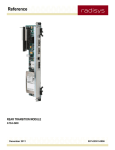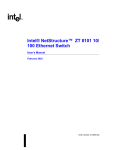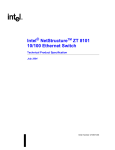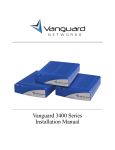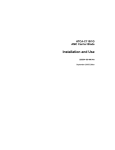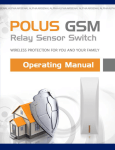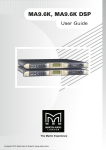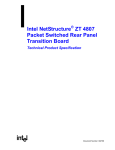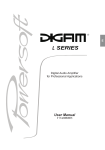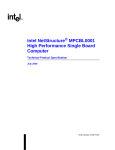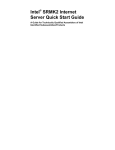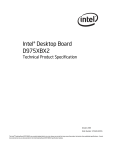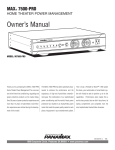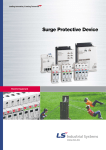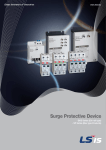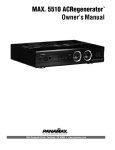Download Intel MPRTM0020 User's Manual
Transcript
Intel NetStructure® MPRTM0020 Rear Transition Module Technical Product Specification April 2006 Order Number: 309383-004 INFORMATION IN THIS DOCUMENT IS PROVIDED IN CONNECTION WITH INTEL® PRODUCTS. NO LICENSE, EXPRESS OR IMPLIED, BY ESTOPPEL OR OTHERWISE, TO ANY INTELLECTUAL PROPERTY RIGHTS IS GRANTED BY THIS DOCUMENT. EXCEPT AS PROVIDED IN INTEL'S TERMS AND CONDITIONS OF SALE FOR SUCH PRODUCTS, INTEL ASSUMES NO LIABILITY WHATSOEVER, AND INTEL DISCLAIMS ANY EXPRESS OR IMPLIED WARRANTY, RELATING TO SALE AND/OR USE OF INTEL PRODUCTS INCLUDING LIABILITY OR WARRANTIES RELATING TO FITNESS FOR A PARTICULAR PURPOSE, MERCHANTABILITY, OR INFRINGEMENT OF ANY PATENT, COPYRIGHT OR OTHER INTELLECTUAL PROPERTY RIGHT. This document and the software described in it are furnished under license and may only be used or copied in accordance with the terms of the license. The information in this document is furnished for informational use only, is subject to change without notice, and should not be construed as a commitment by Intel Corporation. Intel Corporation assumes no responsibility or liability for any errors or inaccuracies that may appear in this document or any software that may be provided in association with this document. Except as permitted by such license, no part of this document may be reproduced, stored in a retrieval system, or transmitted in any form or by any means without the express written consent of Intel Corporation. Contact your local Intel sales office or your distributor to obtain the latest specifications and before placing your product order. Copies of documents which have an ordering number and are referenced in this document, or other Intel literature may be obtained by calling 1-800-548-4725 or by visiting Intel's website at http://www.intel.com. Intel, Intel logo, and Intel NetStructure are trademarks or registered trademarks of Intel Corporation or its subsidiaries in the United States and other countries. *Other names and brands may be claimed as the property of others. Copyright © Intel Corporation, 2006. All rights reserved. 2 Intel NetStructure® MPRTM0020 Technical Product Specification – April 2006 Contents 1 Document Organization ................................................................................................................ 7 1.1 Acronyms and Terms............................................................................................................ 7 2 Functional Overview ..................................................................................................................... 9 3 Operating the Unit ....................................................................................................................... 11 3.1 3.2 3.3 3.4 4 Module Components ................................................................................................................... 14 4.1 4.2 4.3 5 Block Diagram .................................................................................................................... 14 Physical Layout................................................................................................................... 15 Components Description .................................................................................................... 17 4.3.1 Serial Port Interface ............................................................................................... 17 4.3.2 USB Interface ........................................................................................................ 18 4.3.3 Gigabit Ethernet Interface ...................................................................................... 18 4.3.4 SAS Connector Interface ....................................................................................... 19 4.3.5 T1/E1 Connector Interface..................................................................................... 20 4.3.6 Zone 3 Rear Transition Module Power Connector (P30)....................................... 21 4.3.7 Zone 3 Rear Transition Module Data/Control Connectors..................................... 23 4.3.7.1 Zone 3 Rear Transition Module Data/Control Connector (P31) ............. 23 4.3.7.2 Zone 3 Rear Transition Module Data Connector (P32) ......................... 24 4.3.7.3 Zone 3 Rear Transition Module Data Connector (P33) ......................... 24 4.3.8 Alignment Blocks ................................................................................................... 25 4.3.9 ADM1026 Controller ..............................................................................................25 4.3.10 Power Supplies ...................................................................................................... 26 4.3.11 SAS Redriver ......................................................................................................... 27 4.3.12 Board Status LEDs ................................................................................................ 27 4.3.13 RJ-45 Gigabit Ethernet Port LEDs ......................................................................... 28 RTM Management Architecture.................................................................................................. 30 5.1 5.2 5.3 5.4 5.5 5.6 5.7 6 Introduction ......................................................................................................................... 11 RTM Installation Procedure ................................................................................................ 11 RTM Removal Procedure ................................................................................................... 11 Digital Ground to Chassis Ground Connection ................................................................... 12 Introduction ......................................................................................................................... 30 RTM FRU Control ............................................................................................................... 30 M-state Machine ................................................................................................................. 30 Power Budget Management ............................................................................................... 31 LED Management............................................................................................................... 31 SDR Proxy .......................................................................................................................... 31 RTM Sensor Proxy ............................................................................................................. 31 Detailed Specifications ............................................................................................................... 33 6.1 6.2 6.3 6.4 Dimensions and Weight ...................................................................................................... 33 Environmental Specification ............................................................................................... 33 Mechanical Specifications .................................................................................................. 33 6.3.1 Board Outline ......................................................................................................... 33 Reliability Specifications ..................................................................................................... 35 Intel NetStructure® MPRTM0020 Technical Product Specification – April 2006 3 6.4.1 6.5 7 Mean Time Between Failure (MTBF) Specifications ............................................. 35 6.4.1.1 Environmental Assumptions .................................................................. 35 6.4.1.2 General Assumptions............................................................................. 35 6.4.1.3 General Notes........................................................................................ 36 Power Consumption ........................................................................................................... 36 Warranty Information .................................................................................................................. 37 7.1 7.2 8 Intel NetStructure® Compute Boards and Platform Products Limited Warranty................. 37 Returning a Defective Product (RMA) ................................................................................ 37 7.2.1 For the Americas ................................................................................................... 37 7.2.2 For Europe, Middle East, and Africa (EMEA) ........................................................ 38 7.2.3 For Asia and Pacific (APAC).................................................................................. 38 7.2.4 Limitation of Liability and Remedies ...................................................................... 39 Customer Support ....................................................................................................................... 40 8.1 8.2 8.3 8.4 Customer Support............................................................................................................... 40 Technical Support and Return for Service Assistance ....................................................... 40 Sales Assistance ................................................................................................................ 40 Product Code Summary ..................................................................................................... 40 9 Certifications................................................................................................................................ 41 10 Agency Information..................................................................................................................... 42 10.1 10.2 10.3 11 North America (FCC Class A)............................................................................................. 42 Canada – Industry Canada (ICES-003 Class A) ................................................................ 42 European Union.................................................................................................................. 42 Safety Warnings .......................................................................................................................... 44 11.1 Safety Precautions.............................................................................................................. 44 Figures 1 2 3 4 5 6 7 8 9 10 11 12 13 14 15 16 17 4 Relationship of RTM to Front Board ............................................................................................. 9 Default Grounding on MPRTM0020 ........................................................................................... 12 Digital Ground Connected to Chassis Ground ........................................................................... 13 RTM Functional Block Diagram .................................................................................................. 14 Rear Transition Module (RTM) ................................................................................................... 15 RTM Faceplate Connectors and LEDs ....................................................................................... 16 Serial Port Connector ................................................................................................................. 17 USB Connector (J2) ................................................................................................................... 18 RJ-45 Gigabit Ethernet Connector ............................................................................................. 19 SAS Connector ........................................................................................................................... 20 RJ-48 Connector ........................................................................................................................ 21 P30 Connector............................................................................................................................ 22 RTM Power Distribution.............................................................................................................. 26 Physical Breakdown of SAS Ports Distribution........................................................................... 27 RJ-45 Ethernet Port LEDs .......................................................................................................... 28 RTM Temperature Sensor Locations ......................................................................................... 32 Component Layout ..................................................................................................................... 34 Intel NetStructure® MPRTM0020 Technical Product Specification – April 2006 Tables 1 2 3 4 5 6 7 8 9 10 11 12 13 14 15 16 17 18 19 Acronyms and Terms.................................................................................................................... 7 Serial Port Connector Pinout ...................................................................................................... 18 USB Connector Pinout................................................................................................................ 18 RJ-45 Ethernet Connector Pinout............................................................................................... 19 SAS Connector Pinout................................................................................................................ 20 T1/E1 Connector Pinout ............................................................................................................. 21 P30 Connector Pinout................................................................................................................. 22 P30 Signal Descriptions.............................................................................................................. 22 RTM Connector (Zone 3) P31 Pinout ......................................................................................... 23 P31 Signal Descriptions.............................................................................................................. 23 RTM Connector (Zone 3) P32 Pinout ......................................................................................... 24 RTM Connector (Zone 3) P33 Pinout ......................................................................................... 25 GPIO Signal Mapping ................................................................................................................. 25 Board Status LED Descriptions .................................................................................................. 28 Sensor Data Record for RTM ..................................................................................................... 32 Environmental Specifications...................................................................................................... 33 Board Components..................................................................................................................... 35 Reliability Estimate Data............................................................................................................. 35 Product Codes ............................................................................................................................ 40 Intel NetStructure® MPRTM0020 Technical Product Specification – April 2006 5 Revision History Date Revision April 2006 004 Description Updated values for temperature sensor thresholds in “Sensor Data Record for RTM” table. Updated faceplate illustration. Initial production release. 6 January 2006 003 December 2005 002 Added “Operating the Unit”, “RTM Management Architecture”, and “Detailed Specifications” chapters September 2005 001 Initial release of this document. Added new info on grounding procedure, power supplies, SAS redriver, faceplate LEDs, and RTM sensors. Updated P31 pinout. Intel NetStructure® MPRTM0020 Technical Product Specification – April 2006 Document Organization 1 Document Organization The Intel NetStructure® MPRTM0020 Rear Transition Module Technical Product Specification is organized as follows: • Chapter 1, “Document Organization” provides a table of acronyms and terms that are used throughout the document. • Chapter 2, “Functional Overview” describes the features of the Rear Transition Module. • Chapter 3, “Operating the Unit” includes information about installing and removing the Rear Transition Module. • Chapter 4, “Module Components” describes the functional components of the Rear Transition Module. • Chapter 5, “RTM Management Architecture” describes support for a non-intelligent Rear Transition Module in an IPMC environment. • Chapter 6, “Detailed Specifications” includes detailed environmental, mechanical and reliability specifications for the Rear Transition Module. • Chapter 7, “Warranty Information” includes product warranty information. • Chapter 8, “Customer Support” offers technical and sales assistance information for the Rear Transition Module. • Chapter 9, “Certifications” provides information about product certifications. • Chapter 10, “Agency Information” provides product compliance information. • Chapter 11, “Safety Warnings” includes several safety warnings about working with the Rear Transition Module. 1.1 Acronyms and Terms Table 1. Acronyms and Terms (Sheet 1 of 2) Term Definition AdvancedTCA* Advanced Telecommunications Computing Architecture Blade, Board These terms are used interchangeably to refer to an assembled PCB card that plugs into a chassis slot. CPU Central Processing Unit. A microprocessor. DPM Defects Per Million ENA Enable FIT Failures In Time FRU Field Replaceable Unit. Logically represents an entity that can be queried for sensor data, and perhaps an entity that has a satellite management controller. Example FRUs can include an entire SBC or a power supply. HA Highly Available. Intel NetStructure® MPRTM0020 Technical Product Specification – April 2006 7 Document Organization Table 1. Acronyms and Terms (Sheet 2 of 2) Term 8 Definition Hot Swap A specific specification from the PICMG 3.0 Spec. I2 C A two-wire serial bus. Licensed by Phillips Semiconductors. IA-32 32-bit Intel® Architecture I/O Input/Output IPMB Intelligent Platform Management Bus. The bus that interconnects all boards in the chassis to the Shelf Manager. IPMB-0 Intelligent Platform Management Bus Channel 0 as defined in the IPMI v1.5 specification. This is the logical aggregation of IPMB-A and IPMB-B. The use of IPMB Channels 1 through 7 are not defined in this specification. IPMB-R Local IPMI link that is on the “carrier” side of the IPMC device. The IPMC shall proxy for all IPMB-R devices (AMCs and RTM). IPMC Intelligent Platform Management Controller. The portion of a FRU that interfaces to the AdvancedTCA* IPMB-0 and represents that FRU and any device subsidiary to it. IPMI Intelligent Platform Management Interface. The overall specification for doing point-to-point management communication within the chassis over and I2C bus. JBOD Just a Bunch of Drives Node Slot Any standard slot other than a fabric slot OOS Out of Service PCI Peripheral Component Interconnect. Bus technology used to interconnect components in a computer. PICMG PCI Industrial Computer Manufacturers Group PMC PCI Mezzanine Card Power Module Either a power supply or a power entry module RMC RTM Management Controller. The IPMI controller on an RTM, similar to an MMC. RMCP Remote Management Control Protocol. Defined by IPMI 1.5. RMD RTM Management Device. A non-intelligent device (typically an ADM1026) that communicates over I2C to the Front Board IPMC, rather than using IPMB like an RMC does. RTM Rear Transition Module SAS Serial Attached SCSI SDR Sensor Data Record. An IPMI term. Used to describe the name, meaning, and units of measure for a particular data value provided by a PM or BMC. SEL Sensor Event Log. An IPMI defined term. Maintained by the BMC. Shelf A shelf is equivalent to a chassis. Shelf Manager A pluggable board that provides management functions, allowing the chassis backplane to remain passive. Although the term implies a dedicated module, the Shelf Manager may be one function of a multi-function module. For example, the Shelf Manager and a switch can be combined in a single physical module. The Shelf Manager performs the BMC function within the chassis and provides remote management capabilities. SMBus A two-wire serial bus with slightly different electrical and timing characteristics than I2C. This technology is owned by Intel Corporation. SMC Satellite Management Controller. Defined by IPMI. Also known as a peripheral controller or peripheral management controller. Switch Slot See “Fabric Slot” TPS Technical Product Specification Intel NetStructure® MPRTM0020 Technical Product Specification – April 2006 Functional Overview 2 Functional Overview Rear Transition Modules (RTM) are important components in many telecommunications and embedded systems. These environments place most of the active components on a Front Board and most of the cable connections (especially copper cables) are made from the RTM. This allows the Front Board to be replaced without the need to reinsert a large number of cables in the correct order. In AdvancedTCA* systems, the Front Board mates directly with the RTM, as shown in Figure 1: Figure 1. Relationship of RTM to Front Board Front Board RTM The Intel NetStructure® MPRTM0020 Rear Transition Module is designed specifically to work with the Intel NetStructure MPCBL0020 Single Board Computer. The MPRTM0020 RTM includes the following interfaces and features: • One serial port • One USB 1.1 port • Two Gigabit Ethernet (RJ45) ports from the Fabric Interface Intel NetStructure® MPRTM0020 Technical Product Specification – April 2006 9 Functional Overview • One SAS x4 connector to support external SAS JBOD. (Only three of these SAS ports on the RTM are usable; the first SAS port is used by the MPCBL0020 Single Board Computer’s local SAS drive.) • Six T1/E1 ports with transformer and protection circuitry (designed primarily for intrabuilding applications) • I2C connectivity to the SBC for remote management capabilities • OOS and Health LEDs • Hot Swap status LED. This LED mirrors the indication of the HS status LED on the MPCBL0020 Single Board Computer since the MPRTM0020 RTM itself is not hot swappable. • • • • 10 P30 power connector P31, P32, and P33 HM- ZD connectors for SBC signals On-board power conversion from +12V supplied by the SBC via P30 connector ADM1026 for voltage monitoring, storing FRU and SDR data. Intel NetStructure® MPRTM0020 Technical Product Specification – April 2006 Operating the Unit Operating the Unit 3.1 3 Introduction The Intel NetStructure® MPRTM0020 Rear Transition Module is a non-intelligent RTM. A nonintelligent FRU does not have a remote management controller (RMC) on board to communicate with the SBC IPMC. Instead, all of the non-intelligent RTM sensors and FRU device information is made available to the IPMC through direct device access. This is usually done via dummy I2C sensor and storage devices. It is the responsibility of the IPMC to make the non-intelligent RTM look like a separate intelligent FRU controller to the rest of the system. 3.2 RTM Installation Procedure The MPRTM0020 RTM is mechanically compliant with the PICMG*3.0 specifications Revision 2 ECN1. The RTM must be installed in an AdvancedTCA* chassis prior to installing the MPCBL0020 Single Board Computer. Install the RTM as follows: 1. Remove the rear air management blade from an AdvancedTCA chassis (where applicable). 2. Locate the slot where the RTM is to be installed in the chassis. The RTM must be installed in the same slot number as the MPCBL0020 Single Board Computer. 3. Open the top and bottom ejector latches and slide the RTM into the chassis by aligning to the guide rails on the top and bottom of the chassis cage. 4. Ensure that the RTM is fully installed in the chassis by locking the top and bottom ejector handles. 5. Tighten the faceplate retention screws on the top and bottom of the RTM faceplate. Ensure that the screws are torqued to ~6 in-lbs using a torque screwdriver. 3.3 RTM Removal Procedure Removal of the RTM from the chassis uses the following procedure: 1. Because the MPRTM0020 is not an intelligent RTM, removing the RTM causes the SBC to be shut down. Ensure that the SBC is ready to be shut down before opening the bottom ejector handle of the RTM. 2. Remove all interface cables from the RTM faceplate connectors. 3. Loosen the RTM faceplate retention screws with a screwdriver. 4. Open the top and bottom ejector handles on the RTM. 5. Remove the RTM from the chassis slot. Intel NetStructure® MPRTM0020 Technical Product Specification – April 2006 11 Operating the Unit 3.4 Digital Ground to Chassis Ground Connection Digital ground can be tied to chassis ground through a jumper (P2) located near the bottom, right corner of the RTM. In the default grounding for the MPRTM0020, digital ground is isolated from chassis ground (jumper link connecting “NC” to “GND”) as shown in Figure 2. Figure 2. Default Grounding on MPRTM0020 To connect the digital ground to the chassis ground, follow this procedure: 1. Remove the jumper link from the default location on P2 (connecting “NC” & “GND”). 2. Place the jumper link over pins 2 & 3 to connect “GND” to “EGND” as shown in Figure 3. 12 Intel NetStructure® MPRTM0020 Technical Product Specification – April 2006 Operating the Unit Figure 3. Note: Digital Ground Connected to Chassis Ground Digital ground is also called “logic ground”. Chassis ground is also known as “shelf ground”. Intel NetStructure® MPRTM0020 Technical Product Specification – April 2006 13 Module Components 4 Module Components 4.1 Block Diagram Figure 4 shows a functional block diagram of the RTM. Figure 4. RTM Functional Block Diagram P30 Power IPMB/I2C P31 ADM1026 RMD Redriver P32 SAS (x3) 3 SAS Port 2xGbE (from Fabric Interface) USB RJ-45 GbE Port RJ-45 GbE Port USB Port P33 Serial RJ-45 Serial Port From Mezz. #1 2xT1/E1 From Mezz. #2 2xT1/E1 Transformers / Sidactors Backplane 2xT1/E1 1x6 RJ-48C T1/E1 Ports From Mezz. #3 Rear Panel 14 Intel NetStructure® MPRTM0020 Technical Product Specification – April 2006 Module Components 4.2 Physical Layout Figure 5. Rear Transition Module (RTM) Intel NetStructure® MPRTM0020 Technical Product Specification – April 2006 15 Module Components Figure 6 identifies the connectors and LEDs on the RTM faceplate. Figure 6. RTM Faceplate Connectors and LEDs SAS Connector Fabric Interface Port A Fabric Interface Port B OOS LED Health LED USB Connector Serial Port Connector T1/E1 RJ48C from PMC1 T1/E1 RJ48C from PMC2 T1/E1 RJ48C from PMC3 Hot Swap LED 16 Intel NetStructure® MPRTM0020 Technical Product Specification – April 2006 Module Components 4.3 Components Description The following sections describe the components shown in Figure 4 through Figure 6. 4.3.1 Serial Port Interface One serial port (RS-232) connector is present on the RTM. This connector provides access to the COM1 serial port from the MPCBL0020 Single Board Computer, which is also routed to the front panel of the SBC. Both connections are active, but only one can be used at any given time. The line driver/receiver for the serial port resides on the SBC. The RTM only provides a connector along with EMI/EMC filtering. The serial port uses an RJ-45 connector, which is located on the RTM faceplate as shown in Figure 6 on page 16. Figure 7 shows the serial port connector’s outline, and Table 2 provides the pin-out information for this connector. Because this serial port is the COM port from the MPCBL0020 Single Board Computer, the port is inactive when the Serial Over LAN feature is activated on the SBC (the serial port data from COM1 is routed to the Base Interface Gigabit Ethernet adapter in this situation). Figure 7. Serial Port Connector Optional Top Ground Tabs Shielded Modular Jack Assembly Optional Side Ground tabs (2 places) Intel NetStructure® MPRTM0020 Technical Product Specification – April 2006 17 Module Components Table 2. Serial Port Connector Pinout Pin 4.3.2 Signal Name 1 RTS 2 DTR 3 TXD 4 GND 5 GND 6 RXD 7 DSR 8 CTS USB Interface One USB port is provided on the RTM. 5V power is available through this USB port with a current limit of 400mA. Figure 8 illustrates the USB connector and Table 3 provides pinout information. Figure 8. USB Connector (J2) Table 3. USB Connector Pinout Pin 4.3.3 Signal Name 1 5V_USB 2 USB– 3 USB+ 4 GND Gigabit Ethernet Interface Two Gigabit Ethernet ports with LEDs are present on the RTM. Figure 9 shows the physical outline of the RJ-45 connector used for each port, and Table 4 provides the standard pinout information. 18 Intel NetStructure® MPRTM0020 Technical Product Specification – April 2006 Module Components Figure 9. RJ-45 Gigabit Ethernet Connector Table 4. RJ-45 Ethernet Connector Pinout Pin 4.3.4 Signal Name 1 MDI0+ 2 MDI0– 3 MDI1+ 4 MDI2+ 5 MDI2– 6 MDI1– 7 MDI3+ 8 MDI3– SAS Connector Interface One x4 SAS (Serial Attached SCSI) connector is present on the RTM. When the MPRTM0020 is connected to a MPCBL0020 Single Board Computer, only three of the four high-speed serial interfaces is available on the SAS connector, because one port is already used for the on-board local SAS drive on the SBC. The remaining three ports are available as ports 0-2 on the SAS connector (as shown in Figure 14 on page 27) to enable users to connect to a SAS JBOD for remote storage purposes. Figure 10 shows the outline of the SAS connector and Table 5 provides pinout information for the connector. Refer to the Intel NetStructure® MPCBL0020 Single Board Computer Compatibility Report for information on specific SAS cable and SAS JBOD models that have been tested and validated by Intel. Intel NetStructure® MPRTM0020 Technical Product Specification – April 2006 19 Module Components Figure 10. SAS Connector Pin 2 Pin 23 Pin 25 Pin 24 Table 5. SAS Connector Pinout Pin Note: 4.3.5 Pin 3 Pin 1 Signal Name Pin Signal Name 1 GND 14 SAS_TX3– 2 SAS_RX0+ 15 SAS_TX3+ 3 SAS_RX0– 16 GND 4 GND 17 SAS_TX2– 5 SAS_RX1+ 18 SAS_TX2+ 6 SAS_RX1– 19 GND 7 GND 20 SAS_TX1– 8 SAS_RX2+ 21 SAS_TX1+ 9 SAS_RX2– 22 GND 10 GND 23 SAS_TX0– 11 SAS_RX3+ 24 SAS_TX0+ 12 SAS_RX3– 25 GND 13 GND The SAS_RX3 and SAS_TX3 interfaces are not physically connected to the SAS controller on MPCBL0020. The physical routing for these signals exists on the MPRTM0020 but is not supported on the SBC. See Figure 14 “Physical Breakdown of SAS Ports Distribution” on page 27 for further details. T1/E1 Connector Interface Six T1/E1 RJ-48 connectors are present on the RTM. These connectors are designed primarily for intra-building applications. Figure 11 shows the physical outline of the E1/T1 connectors and Table 6 shows pinout information for each connector. 20 Intel NetStructure® MPRTM0020 Technical Product Specification – April 2006 Module Components Figure 11. RJ-48 Connector Table 6. T1/E1 Connector Pinout Pin 4.3.6 T1 Signal E1 Signal 1 RX_RNG RL1 2 RX_TIP RL2 3 Not Used Not Used 4 TX_RNG XL1 5 TX_TIP XL2 6 Not Used Not Used 7 Not Used Not Used 8 Not Used Not Used Zone 3 Rear Transition Module Power Connector (P30) The P30 connector is a bladed connector originally developed for FutureBus* applications. Figure 12 illustrates the connector outline and Table 7 provides pinout information. Table 8 provides additional descriptions of the signals on the connector. Intel NetStructure® MPRTM0020 Technical Product Specification – April 2006 21 Module Components Figure 12. P30 Connector Table 7. P30 Connector Pinout Pin Table 8. Signal Signal A1 (L) Logic_GND A2 (L) Shelf_GND B1 (L) Logic_GND B2 (L) +3.3V_MP C1 (M) IPMI_Sclk C2 (M) IPMI_Sdata D1 (S +12V D2 (S) +12V E1 (S) PS1# E2 (S) ENABLE# P30 Signal Descriptions Pin 22 Pin Signal Comments A1 Logic_GND Logic ground connection (long contact); provides return path for power and signal connections. A2 Shelf_GND Shelf ground connection (long contact); provides safety ground contact between SBC and RTM. B1 Logic_GND Logic ground connection (long contact); see above. B2 +3.3V_MP Management power (long contact); provides up to 100mA to power management system on RTM. Used exclusively for management power. C1 IPMI_Sclk IPMB/I2C clock signal (medium contact) C2 IPMI_Sdata IPMB/ I2C data signal (medium contact); This signal is connected to the on board ADM1026 for temperature and voltage monitoring on the RTM. D1 12V D2 12V E1 PS1# Presence Signal, active low (short contact); the RTM connects this signal to Logic_GND through a 100 Ohm resistor (to facilitate manufacturing test). The Front Board reads this signal to understand if an RTM is fully inserted. E2 ENABLE# Module enable signal, active low (short contact); the Front Board sets this signal high to reset the RMC/RMD. 12V RTM payload power (short contact); provides up to 420mA to power active devices (other than management system) on RTM. See additional requirements below. Intel NetStructure® MPRTM0020 Technical Product Specification – April 2006 Module Components 4.3.7 Zone 3 Rear Transition Module Data/Control Connectors The MPRTM0020 implementation includes three data connectors (P31, P32, P33) that mate directly to the MPCBL0020 Single Board Computer without connecting through the backplane. Each Zone 3 data/control connection consists of 120-pin HM-Zd connector with 40 differential pairs which allows high-speed signals to be passed between the boards. 4.3.7.1 Zone 3 Rear Transition Module Data/Control Connector (P31) The signals that are routed through P31 are the IEEE 1149.1 JTAG signals, SAS storage ports, USB 2.0 signals, and serial and fabric interface Ethernet ports. Table 9 provides the basic pinout of the connector, and Table 10 provides more detail about the signals. Table 9. RTM Connector (Zone 3) P31 Pinout Pin A B C Reserved F TDO G Blue HS LED H RMD_INT# Reserved 2 SA[1]TX+ SA[1]TX- SA[1]RX+ SA[1]RX- SA[2]TX+ SA[2]TX- SA[2]RX+ SA[2]RX- 3 SA[3]TX+ SA[3]TX- SA[3]RX+ SA[3]RX- No Connect No Connect No Connect No Connect 4 FI_DA1+ FI_DA1- FI_DB1+ FI_DB1- FI_DC1+ FI_DC1- FI_DD1+ FI_DD1+ 5 FI_DA2+ FI_DA2- FI_DB2+ FI_DB2- FI_DC2+ FI_DC2- FI_DD2+ FI_DD2+ 6 LNK[0]- ACT[0]- SPD1000[0]- LNK[1]- ACT[1]- SPD1000[1]- Reserved Reserved 7 Reserved Reserved Reserved Reserved Reserved Reserved PCIe_CLK+ PCIe_CLK- 8 Reserved Reserved Reserved Reserved Reserved Reserved Reserved Reserved 9 Reserved Reserved Reserved Reserved Reserved Reserved Reserved Reserved 10 USB[0]+ USB[0]- DSR# RXD# RTS# TXD# CTS# DTR# Pin TDI E 1 Table 10. Reserved D Reserved P31 Signal Descriptions (Sheet 1 of 2) Signal Comments A1 RMD_INT# This signal is driven by the RMD on non-intelligent RTMs to alert the SBC that there is a sensor needing attention. It is required on all SBCs and RTMs. B1, C1 Reserved Reserved D1 TDI Test Data In signal as defined in JTAG. SBCs must connect this signal into the test data chain (i.e., in line with TDO connections from other chips), but must have a means to bypass this connection if an RTM is not installed. E1 Reserved Reserved F1 TDO Test Data Out signal as defined in JTAG. See TDI comments above. Output of RTM G1 Blue HS LED Blue Hot Swap LED H1 Reserved Reserved A2-D3 SA[x]TX+, SA[x]TX-, SA[x]RX+, SA[x]RX- Storage architecture signals for transmit and receive portions of differential pairs. Three SAS ports are routed to the RTM. E3-H3 No Connect No Connect FI_Dxy+, FI_Dxy- PHY-level 10/100/1000Base-T signaling routed to the RTM. Row 4 is for the first Ethernet port, row 5 is for the second Ethernet port. These Ethernet ports are routed from the “Physical Level” Fabric Interface of the MPCBL0020 Single Board Computer, and have gone through the magnetics on the SBC. A4-H5 Intel NetStructure® MPRTM0020 Technical Product Specification – April 2006 23 Module Components Table 10. P31 Signal Descriptions (Sheet 2 of 2) Pin Signal Comments A6-F6 LNK[x], ACT[x], SPD1000[x] Represent the link, activity, and speed LEDs for the Fabric Interface Gigabit Ethernet that are routed to the RTM G6, F7 Reserved Reserved G7, H7 PCIe_CLK+, PCIe_CLK- A8-H9 Reserved Reserved A10B10 USB[0]+, USB[0]- USB data signals. Note that the RTM’s 5 V power for the USB connections must be derived off the 12 V rail. C10 DSR# Data Set Ready signal for COM1 RS-232 connection. D10 RXD# Received Data signal for COM1 RS-232 connection. E10 RTS# Ready to Send signal for COM1 RS-232 connection. F10 TXD# Transmit Data signal for COM1 RS-232 connection. G10 CTS# Clear to Send signal for COM1 RS-232 connection. H10 DTR# Data Terminal Ready signal for COM1 RS-232 connection. 4.3.7.2 PCI Express reference clocks. Any SBC providing PCI Express (pins A3-H4) must provide these signals. * Not supported for the MPRTM0020 RTM. Zone 3 Rear Transition Module Data Connector (P32) The P32 connector on the RTM connects to J32 on the MPCBL0020 Single Board Computer and is used to route the T1/E1 signals from the PMC slots (on the SBC) to the RTM. Table 11 provides the pinout of the P32 connector. AP1[x] designates T1/E1 signals that are routed from PMC 1 while AP2[x] designates T1/E1 signals routed from PMC 2. n Table 11. Pin RTM Connector (Zone 3) P32 Pinout A B AP1[0]RX+ D AP1[0]RX- E AP1[1]TX+ F AP1[1]TX- G AP1[1]RX+ H 1 AP1[0]TX+ 2 AP1[2]TX+ AP1[2]TX- AP1[2]RX+ AP1[2]RX- AP1[3]TX+ AP1[3]TX- AP1[3]RX+ AP1[3]RX- 3 No Connect No Connect No Connect No Connect No Connect No Connect No Connect No Connect 4 No Connect No Connect No Connect No Connect No Connect No Connect No Connect No Connect 5 No Connect No Connect No Connect No Connect No Connect No Connect No Connect No Connect 6 AP2[0]TX+ AP2[1]TX- AP2[0]RX+ AP2[0]RX- AP2[1]TX+ AP2[1]TX- AP2[1]RX+ AP2[1]RX- 7 AP2[2]TX+ AP2[2]TX- AP2[2]RX+ AP2[2]RX- AP2[3]TX+ AP2[3]TX- AP2[3]RX+ AP2[3]RX- 8 No Connect No Connect No Connect No Connect No Connect No Connect No Connect No Connect 9 No Connect No Connect No Connect No Connect No Connect No Connect No Connect No Connect 10 No Connect No Connect No Connect No Connect No Connect No Connect No Connect No Connect 4.3.7.3 AP1[1]TX- C AP1[1]RX- Zone 3 Rear Transition Module Data Connector (P33) The P33 connector on the RTM connects to J33 on the MPCBL0020 Single Board Computer and is used to route the remainder of the T1/E1 signals from PMC slot 3 on the SBC to the RTM. Table 12 provides the pinout of the P33 connector. 24 Intel NetStructure® MPRTM0020 Technical Product Specification – April 2006 Module Components AP3[x] indicates that these T1/E1 signals are routed from PMC 3. Table 12. Pin RTM Connector (Zone 3) P33 Pinout A B C D E F G H 1 AP3[0]TX+ AP3[1]TX- AP3[0]RX+ AP3[0]RX- AP3[1]TX+ AP3[1]TX- AP3[1]RX+ AP3[1]RX- 2 AP3[2]TX+ AP3[2]TX- AP3[2]RX+ AP3[2]RX- AP3[3]TX+ AP3[3]TX- AP3[3]RX+ AP3[3]RX- 3 No Connect No Connect No Connect No Connect No Connect No Connect No Connect No Connect 4 No Connect No Connect No Connect No Connect No Connect No Connect No Connect No Connect 5 No Connect No Connect No Connect No Connect No Connect No Connect No Connect No Connect 6 No Connect No Connect No Connect No Connect No Connect No Connect No Connect No Connect 7 No Connect No Connect No Connect No Connect No Connect No Connect No Connect No Connect 8 No Connect No Connect No Connect No Connect No Connect No Connect No Connect No Connect 9 No Connect No Connect No Connect No Connect No Connect No Connect No Connect No Connect 10 No Connect No Connect No Connect No Connect No Connect No Connect No Connect No Connect 4.3.8 Alignment Blocks The MPRTM0020 Rear Transition Module implements the rK1 and A2 alignment blocks at the top of Zone 2 and Zone 3, as required in Section 2.4.4 of the PICMG 3.0 Specification. The Zone 2 alignment block (rK1) is assigned a keying value of 11, and uses Tyco* 1-1469373-1 (or equivalent). The Zone 3 alignment block (A2) is assigned a keying value of 7-3, and uses Tyco 7-1469373-3 (or equivalent). 4.3.9 ADM1026 Controller The RTM has an ADM1026 controller that collects sensor information from the board using the SMBus interface. It also has memory to store FRU and user information. The ADM1026 is managed by the MPCBL0020 Single Board Computer IPMC connected via the I2C bus. These I2C signals are routed from the SBC IPMC through the P30 connector on the Zone 3. The SBC IPMC communicates with the ADM1026 using an I2C address of 0x5C. From the Shelf management perspective, the RTM can be managed using the IPMB address fronted by the SBC (MPCBL0020) with a FRU Device ID of 0x04. Refer Section 5 for further information regarding management of the FRU and SDR data of the RTM.Table 13 shows mapping between GPIO signal name and pin on the ADM1026. Table 13. GPIO Signal Mapping (Sheet 1 of 2) GPIO Signals Pin on ADM1026 Hotswap_Switch 3 OOS Green LED Control 6 OOS Red LED Control 5 Health Green LED Control 10 Intel NetStructure® MPRTM0020 Technical Product Specification – April 2006 25 Module Components Table 13. GPIO Signal Mapping (Sheet 2 of 2) GPIO Signals 4.3.10 Pin on ADM1026 Health Red LED Control 9 USB_OC Monitor 12 Payload Power Enable 2 Payload PowerGood 43 Power Supplies The MPRTM0020 RTM needs several voltages that are not available from the SBC. The P30 connection to the SBC only provides two power supplies: • +12 V voltage rail (420 mA maximum current) is used as the main input voltage for the RTM • +3.3 V SUS voltage powers the management circuitry on the RTM (ADM1026, I2C pullup, etc.) Voltage regulation on the RTM is used to generate the additional required voltages, as shown in Figure 13. Figure 13. RTM Power Distribution Inputvia P30 (from M PC BL0020) 12V/5V C onverter 12V +5V 5V/3.3V C onverter +3.3V 3.3V/1.8V C onverter +1.8V +3.3V_SU S 3.3V/5V C onverter +5V_SU S ForM anagem entC ircuitry The four voltages that are generated on the RTM are used as follows: • +5V_SUS: The +5V_SUS is mainly used as an input voltage to drive the blue Hot Swap LED. It is generated from the +3.3V_SUS using a boost regulator. • +5V: The 5 V payload voltage is generated from the +12 V power. To increase the power conversion efficiency, a switching regulator is added. The 5 V is mainly used for USB power and also used as a supply to 5 V/3.3 V linear regulator. • +3.3V: The 3.3 V voltage is used to drive the components on the SAS re-driver circuitry. This voltage is also used to drive the Gigabit Ethernet LINK/ACTIVITY LEDs on the RTM. 26 Intel NetStructure® MPRTM0020 Technical Product Specification – April 2006 Module Components • +1.8V: The 1.8 V voltage is used as the input voltage to the SAS re-driver IC. 4.3.11 SAS Redriver The MPCBL0020 Single Board Computer implements optional SAS storage access via the MPRTM0020 RTM. SAS is a 3-Gbps SERDES style bus, and a redriver is added on the RTM to effectively detect and correct the SAS OOB signals at a proper amplitude. The specific SAS re-driver that was used is the PMC-Sierra* PM8380 Quad SMX 3G SATA/SAS Mux/Demux. The RTM implements the PM8380 device as a 1:1 re-driver. The four host ports are connected to the SBC via the Zone 3 connector. The four SAS ports of the “B” Load-side Mux-port are connected to the External SAS connector. The “A” Load-side Mux-port is left unconnected. The PM8380 has its configuration straps set to operate in re-driving mode, rather than in Mux mode. The “B” Load-side Mux-port is configured for the default SAS amplitude, pre-emphasis, and equalization. Figure 14 illustrates the SAS port distribution on the RTM. Figure 14. Only three SAS ports are routed to the MPRRTM0020 RTM because the first SAS port from the SAS HBA (port 0) is used for the on-board SAS hard drive on the MPCBL0020 SBC. Physical Breakdown of SAS Ports Distribution MPCBL0020 SBC MPRTM0020 RTM SAS HDD J31P31 0 1 2 3 B-Port 0 Host Port SAS Re-driver 0 1 2 3 SAS Connector Note: A-Port (Not Connected) 4-Port SAS HBA 4.3.12 0 1 2 3 External cable to a SAS JBOD Board Status LEDs The Hot Swap, Out of Service, and Health LEDs on the RTM faceplate are fronted by the MPCBL0020 Single Board Computer. These LEDs have identical state to the LEDs on the SBC faceplate and allow service personnel to verify the state of the board when servicing the board from the rear of the chassis. Intel NetStructure® MPRTM0020 Technical Product Specification – April 2006 27 Module Components Table 14. Board Status LED Descriptions LED Hot Swap Function Function: Hot Swap as defined in AdvancedTCA 3.0 Specification It is also possible for a user to override the default behavior of the LED using AdvancedTCA FRU LED Control commands. Possible States: OFF / BLUE / SHORT BLINK / LONG BLINK Blinking Blue: Preparing for removal/insertion. Long blink indicates activation is in progress, short blink when deactivation is in progress Out of Service Health Function: Out of Service (AdvancedTCA LED 1). RED: The board is out of service. OFF: The board is running. It is possible for a user to override the default IPMC behavior of the LED using AdvancedTCA FRU LED Control commands. Possible States: OFF / RED / AMBER Function: Health (AdvancedTCA LED 2). The SBC health is based on an aggregation of IPMI sensors, like board temperature and voltage. Green: The SBC is healthy. Red: The SBC is not healthy. It is possible for the user to override the default IPMC behavior of the LED using AdvancedTCA FRU LED Control commands. Possible States: OFF / GREEN / RED / AMBER 4.3.13 RJ-45 Gigabit Ethernet Port LEDs The RJ-45 connector for each of the Gigabit Ethernet ports on the RTM has two indicator LEDs integrated in the connector body. As shown in Figure 15, the top LED represents the LINK LED while the bottom LED represents the SPEED LED. Figure 15. 28 RJ-45 Ethernet Port LEDs Intel NetStructure® MPRTM0020 Technical Product Specification – April 2006 Module Components The LINK LED has the following indications and meanings: • LED Off – Link not established • Steady green – Link established but not active • Flashing green – Link established and currently active When the LINK LED is illuminated, the SPEED LED has the following indications and meanings: • Steady green – 10/100 Mbps connection • Steady amber – 1000 Mbps connection Note: When the Fabric Interface Gigabit Ethernet links from the MPCBL0020 Single Board Computer are routed to the switch slots, the Ethernet connections on the RTM are not active. However, the Speed and Link LEDs on the connectors will still indicate the operational status of the Ethernet ports. Intel NetStructure® MPRTM0020 Technical Product Specification – April 2006 29 RTM Management Architecture RTM Management Architecture 5.1 5 Introduction This section describes the management support for a non-intelligent Rear Transition Module (RTM) such as the MPRTM0020. A non-intelligent RTM FRU does not have a controller on board to communicate with the SBC IPMC. Instead, all of the non-intelligent RTM sensors and the nonintelligent RTM FRU storage device are connected directly to the SBC IPMC. This is usually done via dummy I2C sensor and storage devices. It is the responsibility of the SBC IPMC to make the non-intelligent RTM look like a separate intelligent FRU controller to the rest of the system. The feature that is not supported for RTMs is E-keying, since there are no PICMG requirements defined for non-intelligent RTMs. 5.2 RTM FRU Control Since the non-intelligent RTM does not have a payload, the SBC IPMC only needs to implement the Cold Reset version of the FRU control command. This command does not cause the IPMC to reset. Instead the command causes all of the sensor and state information for the non-intelligent RTM to be set back to startup values, simulating a controller reset. 5.3 M-state Machine The SBC IPMC is responsible for implementing the M-State machine for the non-intelligent RTM. From the perspective of the Shelf Manager the non-intelligent RTM looks like a separate managed FRU device with its own M-state that is separate from that of the IPMC. In order to do this, the IPMC sends M-State transition messages to the Shelf Manager, accepts activation/deactivation requests from the Shelf Manager, and negotiates power budgeting as if it were a separate RTM controller. The non-intelligent RTM is not intended to be hot-swapped in or out of the system. For this reason the handle switch on the non-intelligent RTM is combined with the handle switch on the SBC. If either handle switch is opened, both the non-intelligent RTM and the SBC will take the appropriate action for removal. When the SBC is inserted into the system the non-intelligent RTM is initialized to M0 state. The SBC IPMC then checks for the presence of the non-intelligent RTM. If the non-intelligent RTM is present then the non-intelligent RTM M-State is set to M1. In the M1 state the SDR records in the non-intelligent RTM FRU device are incorporated with the IPMC SDR records. The nonintelligent RTM then remains in M1 until the SBC IPMC reaches M4. At that point the nonintelligent RTM transitions to M2 and waits for activation from the Shelf Manager. Once the Shelf Manager activates the non-intelligent RTM, the non-intelligent RTM transitions to M3 and waits for its power budget to be granted. Once the power budget is granted the non-intelligent RTM transitions to M4 and stays there until a deactivation is received from the Shelf Manager or a handle switch is opened. 30 Intel NetStructure® MPRTM0020 Technical Product Specification – April 2006 RTM Management Architecture 5.4 Power Budget Management The SBC IPMC has inherent knowledge of the non-intelligent RTM power requirements. The IPMC will handle power negotiation commands from the Shelf Manager that are targeted for the non-intelligent RTM FRU ID. By doing this, the Shelf Manager should see the non-intelligent RTM as a separate controller negotiating for a power budget. 5.5 LED Management The SBC IPMC has direct control over the LEDs on the non-intelligent RTM. Control of these LEDs is done through the IPMC system attention manager in the same way as other IPMCcontrolled LEDs. Special fault classes are added to system attention manager tables to handle the failure and status state of the non-intelligent RTM. The non-intelligent RTM sensors and M-State machine are the contributors to the failure and status state. When the non-intelligent RTM is present, its failures will contribute to the overall failure state of the IPMC. Thus, the non-intelligent RTM LEDs will match the SBC LEDs. 5.6 SDR Proxy The SDR records for the non-intelligent RTM are stored in a proprietary format in the internal use area of the non-intelligent RTM FRU storage device. When the non-intelligent RTM reaches M1 state the non-intelligent RTM SDR records are read out of the FRU device and stored in the IPMC. The non-intelligent RTM SDR records are then merged with the IPMC SDR records and made available through the Device SDR IPMI commands. 5.7 RTM Sensor Proxy The non-intelligent RTM sensors are included in the sensor compliment programmed in the SBC IPMC. The only difference is that the non-intelligent RTM sensors are turned on and off with respect to the non-intelligent RTM M-State. When the non-intelligent RTM is in M4 state the sensors are turned on and scanned by the IPMC. In any other M-state the sensors are not scanned and will return a “sensor not found” completion code to sensor commands. When the nonintelligent RTM sensors are turned on the IPMC handles event generation and sensor access commands for the non-intelligent RTM sensors just as it does for any other IPMC sensor. Below is a list of the current non-intelligent RTM sensors: • • • • • • • RTM +1.8V RTM +3.3V RTM +3.3V Standby RTM +5.0V RTM +5.0V Standby RTM +12V RTM Temp1 Intel NetStructure® MPRTM0020 Technical Product Specification – April 2006 31 RTM Management Architecture • RTM Temp2 • RTM Temp3 • RTM Power Status Table 15. Sensor Data Record for RTM Sensor Name Figure 16. 32 Lower Critical Description Lower Non Critical Upper Non Critical Upper Critical RTM +1.8V For SAS Retimer 1.71 – – 1.89 RTM +3.3V For other Integrated Circuits 3.10 – – 3.47 RTM +3.3V SUS Early voltage for ADM1026 3.11 – – 3.46 RTM +5.0V For USB Interface 4.71 – – 5.23 RTM +5V SUS Early voltage for Hotswap LED 4.73 – – 5.25 RTM +12V Main voltage rail for other ICs/ peripherals 10.71 – – 13.10 RTM Temp 1 Internal ADM1026 (U3) [see Figure 16 for location] -5 – 70 75 RTM Temp 2 External Thermal Diode (Q3) [see Figure 16 for location] -5 – 70 75 RTM Temp 3 External Thermal Diode (Q2) [see Figure 16 for location] -5 – 70 75 RTM Temperature Sensor Locations Intel NetStructure® MPRTM0020 Technical Product Specification – April 2006 Detailed Specifications 6 Detailed Specifications 6.1 Dimensions and Weight The weight of the baseboard is 1.14 kg (2.5 lbs.) with packaging materials. 6.2 Environmental Specification The test methodology is a combination of Intel and NEBS test requirements with the intent that the product will pass pure system-level NEBS testing. The following table summarizes environmental limits, both operating and nonoperating. Table 16. Environmental Specifications Parameter Temperature (Ambient) Conditions Detailed Specification Operating (Normal 5°C to 40°C Operating (Short term) -5°C to 55°C Storage -40°C to 70° C Operating 15%-90% (non-condensing) at 55° C Storage 5%-95% (non-condensing) at 40° C Humidity Operating Altitude Storage 4,000 m (13,100 ft.) Note: may require additional cooling above 1800 m (5,900 ft.) 15,000 m (49,200 ft.) Sine sweep: • 5 to 100 Hz: 1G @ 0.25 Octave/minute • 100 to 500 Hz: 1G @ 1 Octave/minute Operating Unpackaged Vibration Random profile: • 5 Hz @ 0.01 g2 /Hz to 20 Hz @ 0.02 g2 /Hz (slope up) • 20 Hz to 500 Hz @ 0.02 g2 /Hz (flat) • 3.13 g RMS, 10 minutes per axis for all three axes Storage 5 Hz to 50 Hz: 0.5 G @ 0.1 Octave/minute 50 Hz to 500 Hz: 3 G @ 0.25 Octave/minute. Operating 30 G/11 ms half sine Storage 50 G, 170 inches/second trapezoidal Shock 6.3 Mechanical Specifications 6.3.1 Board Outline The MPRTM0020 printed circuit board (PCB) is mechanically compliant with the PICMG 3.0 Specification dimensions of 322.25 mm x 70.00 mm. The board pitch is 6HP. Intel NetStructure® MPRTM0020 Technical Product Specification – April 2006 33 Detailed Specifications Figure 17 below shows the locations of major components of the MPRTM0020. Table 17 lists the components shown in the illustration. Figure 17. 34 Component Layout Intel NetStructure® MPRTM0020 Technical Product Specification – April 2006 Detailed Specifications Table 17. Board Components Component/Function A SAS Retimer B RMD/ENA jumper. Used to bypass the manageability by the MPCBL0020 SBC IPMC for debugging purposes. Not intended to be use in any field deployment, because changing this default jumper affects the RTM manageability from the ShMC. C ADM1026 D Digital/Chassis Ground Jumper 6.4 Reliability Specifications 6.4.1 Mean Time Between Failure (MTBF) Specifications Calculation Type: MTBF/FIT Rate Standard: Telcordia* Standard SR-332 Issue 1 Methods: Method I, Case I, Quality Level II The calculation results were generated using the references and assumptions listed. This report and its associated calculations supersede all other released mean time between failures (MTBF) and Failure in Time (FIT) calculations of earlier report dates. The reported failure rates do not represent catastrophic failure. Catastrophic failure rates will vary based on application environment and features critical to the intended function. Table 18. 6.4.1.1 Reliability Estimate Data Failure Rate (FIT) 913 failures in 109 hours MTBF 1,095,000 hours Environmental Assumptions • Failure rates are based on a 40° C ambient temperature. • Applied component stress levels are 50% (voltage, current, and/or power). • Ground, fixed, controlled environment with an environmental adjustment factor equal to 1.0. 6.4.1.2 General Assumptions • Component failure rates are constant. • Board-to-system interconnects included within estimates. • Non-electrical components (screws, mechanical latches, labels, covers, etc.) are not included within estimations. • Printed circuit board is considered to have a 0 FIT rate. Intel NetStructure® MPRTM0020 Technical Product Specification – April 2006 35 Detailed Specifications 6.4.1.3 General Notes • Method I, Case I = Based on parts count. Equipment failure is estimated by totaling device failures rates and quantities used. • Quality Level II = Devices purchased to specifications, qualified devices, vendor lot-to-lot controls for AQLs and DPMs. Where available, direct component supplier predictions or actual FIT rates have been used. 6.5 Power Consumption The maximum power consumption of the MPRTM0020 is 5 watts. The typical power consumption is 4 watts (with SAS re-timer and USB consuming 2 watts each). 36 Intel NetStructure® MPRTM0020 Technical Product Specification – April 2006 Warranty Information Warranty Information 7.1 7 Intel NetStructure® Compute Boards and Platform Products Limited Warranty Intel warrants to the original owner that the product delivered in this package will be free from defects in material and workmanship for two (2) year(s) following the latter of: (i) the date of purchase only if you register by returning the registration card as indicated thereon with proof of purchase; or (ii) the date of manufacture; or (iii) the registration date if by electronic means provided such registration occurs within 30 days from purchase. This warranty does not cover the product if it is damaged in the process of being installed. Intel recommends that you have the company from whom you purchased this product install the product. THE ABOVE WARRANTY IS IN LIEU OF ANY OTHER WARRANTY, WHETHER EXPRESS, IMPLIED OR STATUTORY, INCLUDING, BUT NOT LIMITED TO, ANY WARRANTY OF MERCHANTABILITY, FITNESS FOR A PARTICULAR PURPOSE, ANY WARRANTY OF INFRINGEMENT OF ANY OTHER PARTY'S INTELLECTUAL PROPERTY RIGHTS, OR ANY WARRANTY ARISING OUT OF ANY PROPOSAL, SPECIFICATION OR SAMPLE. This warranty does not cover replacement of products damaged by abuse, accident, misuse, neglect, alteration, repair, disaster, improper installation or improper testing. If the product is found to be otherwise defective, Intel, at its option, will replace or repair the product at no charge except as set forth below, provided that you deliver the product along with a return material authorization (RMA) number (see below) either to the company from whom you purchased it or to Intel. If you ship the product, you must assume the risk of damage or loss in transit. You must use the original container (or the equivalent) and pay the shipping charge. Intel may replace or repair the product with either a new or reconditioned product, and the returned product becomes Intel's property. Intel warrants the repaired or replaced product to be free from defects in material and workmanship for a period of the greater of: (i) ninety (90) days from the return shipping date; or (ii) the period of time remaining on the original two (2) year warranty. This warranty gives you specific legal rights and you may have other rights which vary from state to state. All parts or components contained in this product are covered by Intel's limited warranty for this product. The product may contain fully tested, recycled parts, warranted as if new. 7.2 Returning a Defective Product (RMA) Before returning any product, contact an Intel Customer Support Group to obtain either a Direct Return Authorization (DRA) or Return Material Authorization (RMA). Return Material Authorizations are only available for products purchased within 30 days. 7.2.1 For the Americas Return contact information by geography: Return Material Authorization (RMA) credit requests e-mail address: [email protected] Intel NetStructure® MPRTM0020 Technical Product Specification – April 2006 37 Warranty Information Direct Return Authorization (DRA) repair requests e-mail address: [email protected] DRA on-line form: http://support.intel.com/support/motherboards/draform.htm Intel Business Link (IBL): http://www.intel.com/ibl Telephone No.: 1-800-INTEL4U or 480-554-4904 Office Hours: Monday - Friday 0700-1700 MST Winter / PST Summer 7.2.2 For Europe, Middle East, and Africa (EMEA) Return Material Authorization (RMA) e-mail address [email protected] Direct Return Authorization (DRA) for repair requests e-mail address: [email protected] Intel Business Link (IBL): http://www.intel.com/ibl Telephone No.: 00 44 1793 403063 Fax No.: 00 44 1793 403109 Office Hours: Monday - Friday 0900-1700 UK time 7.2.3 For Asia and Pacific (APAC) RMA/DRA requests e-mail address: [email protected] Telephone No.: 604-859-3111 or 604-859-3325 Fax No.: 604-859-3324 Office Hours: Monday - Friday 0800-1700 Malaysia time Return Material Authorization (RMA) requests e-mail address: [email protected] Telephone No.: 81-298-47-0993 or 81-298-47-5417 Fax No.: 81-298-47-4264 Direct Return Authorization (DRA) for repair requests, contact the JPSS Repair center. E-mail address: [email protected] Telephone No.: 81-298-47-8920 Fax No.: 81-298-47-5468 Office Hours: Monday - Friday 0830-1730 Japan time If the Customer Support Group verifies that the product is defective, they will have the Direct Return Authorization/Return Material Authorization Department issue you a DRA/RMA number to place on the outer package of the product. Intel cannot accept any product without a DRA/RMA number on the package. 38 Intel NetStructure® MPRTM0020 Technical Product Specification – April 2006 Warranty Information 7.2.4 Limitation of Liability and Remedies INTEL SHALL HAVE NO LIABILITY FOR ANY INDIRECT OR SPECULATIVE DAMAGES (INCLUDING, WITHOUT LIMITING THE FOREGOING, CONSEQUENTIAL, INCIDENTAL AND SPECIAL DAMAGES) ARISING FROM THE USE OF OR INABILITY TO USE THIS PRODUCT, WHETHER ARISING OUT OF CONTRACT, NEGLIGENCE, TORT, OR UNDER ANY WARRANTY, OR FOR INFRINGEMENT OF ANY OTHER PARTY'S INTELLECTUAL PROPERTY RIGHTS, IRRESPECTIVE OF WHETHER INTEL HAS ADVANCE NOTICE OF THE POSSIBILITY OF ANY SUCH DAMAGES, INCLUDING, BUT NOT LIMITED TO LOSS OF USE, BUSINESS INTERRUPTIONS, AND LOSS OF PROFITS. NOTWITHSTANDING THE FOREGOING, INTEL'S TOTAL LIABILITY FOR ALL CLAIMS UNDER THIS AGREEMENT SHALL NOT EXCEED THE PRICE PAID FOR THE PRODUCT. THESE LIMITATIONS ON POTENTIAL LIABILITIES WERE AN ESSENTIAL ELEMENT IN SETTING THE PRODUCT PRICE. INTEL NEITHER ASSUMES NOR AUTHORIZES ANYONE TO ASSUME FOR IT ANY OTHER LIABILITIES. Some states do not allow the exclusion or limitation of incidental or consequential damages, so the above limitations or exclusions may not apply to you. Intel NetStructure® MPRTM0020 Technical Product Specification – April 2006 39 Customer Support 8 Customer Support 8.1 Customer Support This chapter offers technical and sales assistance information for this product. 8.2 Technical Support and Return for Service Assistance For all product returns and support issues, please contact your Intel product distributor or Intel Sales Representative for specific information. 8.3 Sales Assistance If you have a sales question, please contact your local Intel NetStructure Sales Representative or the Regional Sales Office for your area. Address, telephone and fax numbers, and additional information is available at Intel’s web site located at: http://www.intel.com/network/csp/sales/ Intel Corporation Telephone (in U.S.) 1-800-755-4444 Telephone (Outside U.S.) 1-973-993-3030 FAX 1-973-967-8780 8.4 Product Code Summary Table 19 lists the MPRTM0020 product code: Table 19. 40 Product Codes Product Code MM# Description MPRTM0020S01Q 882004 MPRTM0020 Rear Transition Module Intel NetStructure® MPRTM0020 Technical Product Specification – April 2006 Certifications Certifications 9 Safety: • IEC60950-1 • EN60950 • UL/CSA 60950-1 Hazardous substances: • The Intel NetStructure® MPRTM0020S00Q has been verified to be compliant with the European Directive 2002/95/EC, officially titled “The Restriction on the Use of Hazardous Substances (RoHS) in Electrical and Electronic Equipment” or RoHS. Specifically, this product uses only RoHS compliant parts and Pb-free solder and may take advantage of certain exemptions referenced within the Directive. Electromagnetic Compatibility (EMC) emissions: • • • • CISPR22/EN55022 Class A EN300386 FCC Rules CFR 47 Part 15B Class A ICES-003 Class A Electromagnetic Compatibility (EMC) immunity: • CISPR24/EN55024 • EN300386 Network Equipment Building System (NEBS) compliance: • The MPCBL0020 SBC meets the board-level specifications as specified in the Intel Environmental Standards Handbook – Telco Specification Document No. A78805-01. The test methodology is a combination of Intel and NEBS test requirements with the intent that the product will pass pure system-level NEBS testing. Intel has performed limited NEBs testing. Among these are GR-1089-CORE: ESD, radiated emissions (E- and H-field), conducted emissions, radiated immunity, and conducted immunity. Telecom Compliance of T1/E1 Ports: • The T1/E1 ports of the MPRTM0020 have not been tested for compliance against any telecommunications standards. It is the responsibility of the final integrator to obtain telecom attachment approvals for their combination of PMC and RTM T1/E1 configuration. Intel NetStructure® MPRTM0020 Technical Product Specification – April 2006 41 Agency Information Agency Information 10.1 10 North America (FCC Class A) Federal Communications Commission (FCC) Part 15 Rules This equipment has been tested and found to comply with the limits for a Class A digital device, pursuant to Part 15 of the FCC Rules. These limits are designed to provide reasonable protection against harmful interference when the equipment is operated in a commercial environment. This equipment generates, uses, and can radiate radio frequency energy and, if not installed and used in accordance with the instruction manual, may cause harmful interference to radio communications. Operation of this equipment in a residential area is likely to cause harmful interference, in which case the user will be required to correct the interference at his own expense. 10.2 Canada – Industry Canada (ICES-003 Class A) Industry Canada ICES-003 Issue 3 This Class A digital apparatus meets all requirements of the Canadian Interference-Causing Equipment Regulations. Cet appareil numérique de la classe A respecte toutes les exigences du Règlement sur le matérial brouilleur du Canada. 10.3 European Union The products covered by this notice meet the following European Directives: • 73/23/EECLow Voltage Directive • 89/336/EECEMC Directive To achieve CE compliance, be sure to select a host that already meets the EMC and Low Voltage Directives before the addition of any optional board. Remember that the use of option boards declared compliant with the Directives by their manufacturer only gives “presumption of compliance” for the whole system. It is the responsibility of the system supplier to verify that the requirements of the listed Directives are still met by the final system, as supplied to the end-user. System integrators should take notice of further conditions expressed in the sections below and the Safety Information sheet supplied with each board. Warning: 42 This is a class A product. In a domestic environment this product may cause radio interference in which case the user may be required to take adequate measures. Intel NetStructure® MPRTM0020 Technical Product Specification – April 2006 Agency Information Compliance with the R&TTE Directive The R&TTE Directive includes its own safety and EMC requirements. Although equipment declared compliant to the R&TTE Directive does not require explicit declaration of conformity to EMC and Low Voltage Directives, above conditions must also be met to satisfy the safety and EMC requirements of the R&TTE Directive. Intel Declarations of Conformity for the products covered by this notice can be found under the “Network Building Blocks” heading at http://developer.intel.com/design/litcentr/ce_docs. Manufacturer's office in European Union: Intel Corporation (UK) Ltd. Pipers Way Swindon, Wiltshire SN3 1RJ UK Tel: +44 (0)1793 403000 Fax: +44 (0)1793 641440 Intel NetStructure® MPRTM0020 Technical Product Specification – April 2006 43 Safety Warnings Safety Warnings 11.1 11 Safety Precautions Review the following precautions to avoid personal injury and prevent damage to this product or products to which it is connected. To avoid potential hazards, use the product only as specified. Read all safety information and understand the precautions associated with safety symbols, written warnings, and cautions before accessing parts or locations within the unit. System for Restricted Access Use Only! Warning: To avoid the risk of electrical shock hazard, special measures and precautions must be taken when using these products: — Access to this equipment must be restricted by locating this equipment where access can only be gained by SERVICE PERSONNEL who have been informed about the reasons for the restrictions applied to the location and about any precautions that shall be taken. Access is through the use of a TOOL, lock and key, or other means of security and is controlled by the authority responsible for the location. — This product should only be used by SERVICE PERSONNEL who have the knowledge and training required to work with products of this type. — To avoid shock, ensure that the chassis power cables are connected to a properly wired and grounded receptacle. — The system containing these boards should not be operated with the faceplates, blank panels, or covers removed. Some voltages, that are on the board and inside the chassis, present an electrical shock and/or energy hazard to the user. Keep hands out of the chassis when power is applied or when performing hot swap of the boards. 44 Intel NetStructure® MPRTM0020 Technical Product Specification – April 2006













































